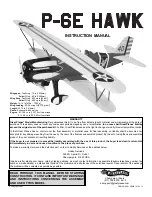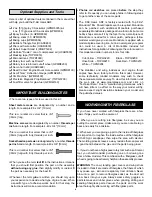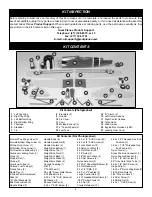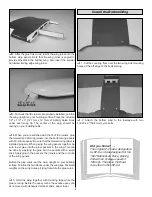
INTRODUCTION ...............................................................2
IMAA..................................................................................2
SAFETY PRECAUTIONS..................................................2
ADDITIONAL ITEMS REQUIRED.....................................3
Hardware & Accessories .............................................3
Adhesives & Building Supplies....................................3
Optional Supplies & Tools ...........................................4
IMPORTANT BUILDING NOTES ......................................4
INFORMATION ABOUT WORKING WITH FIBERGLASS ...4
KIT INSPECTION ..............................................................5
KIT CONTENTS ................................................................5
ORDERING REPLACEMENT PARTS ..............................6
PREPARATIONS ...............................................................7
BUILD THE WINGS ...........................................................7
Installing the Ailerons ..................................................7
Join The Top Wing Panels ...........................................8
Join The Bottom Wing Panels .....................................8
Install The Bottom Wing ..............................................9
INSTALL THE STABILIZER AND FIN ............................10
Install The Stabilizer And Elevator.............................10
Install The Fin And Rudder .......................................10
INSTALL THE MAIN LANDING GEAR ...........................12
INSTALL THE ENGINE ...................................................13
Mount The Engine .....................................................13
Mount The Cowl ........................................................14
Install The Fuel Tank .................................................15
Install The Throttle Servo ..........................................16
Finish Assembling The Cowl .....................................17
INSTALL THE RADIO SYSTEM......................................18
Install The Rudder And Elevator Servos ...................18
Install The Aileron Servos & Pushrods......................21
INSTALL THE TOP WING................................................22
FINISH THE FUSELAGE.................................................23
Build The Carrying Handle ........................................23
Assemble The Nose Weight Box ...............................25
Finishing Touches......................................................25
Optional Flying Wire Installation................................26
Apply The Decals ......................................................29
GET THE MODEL READY TO FLY .................................30
Check the Control Directions ....................................30
Set the Control Throws..............................................30
Balance the Model (C.G.)..........................................30
Balance the Model Laterally......................................31
PREFLIGHT.....................................................................31
Identify Your Model ....................................................31
Charge the Batteries .................................................31
Balance the Propellers ..............................................32
Ground Check ...........................................................32
Range Check.............................................................32
ENGINE SAFETY PRECAUTIONS.................................32
AMA SAFETY CODE (
EXCERPTS
) ....................................33
IMAA SAFETY CODE (
EXCERPTS
) ...................................33
CHECK LIST ...................................................................34
FLYING ............................................................................34
Fuel Mixture Adjustments..........................................34
Take Off .....................................................................34
Flight..........................................................................35
Landing......................................................................35
The P-6E Hawk has a long and colorful history in both the
U.S. military and abroad. You will thoroughly enjoy the wide
range of capabilities of this plane as well as its good looks.
We think you will be pleased with its attention to detail and
flight characteristics.
For the latest technical updates or manual corrections to the
P-6E Hawk ARF, visit the Great Planes web site at
www.greatplanes.com. Open the “Airplanes” link, then
select the P-6E Hawk ARF. If there is new technical
information or changes to this model a “tech notice” box will
appear in the upper left corner of the page.
The P-6E Hawk ARF is an excellent sport-scale model and
is eligible to fly in IMAA events. The IMAA (International
Miniature Aircraft Association) is an organization that
promotes non-competitive flying of giant-scale models. If
you plan to attend an IMAA event, obtain a copy of the IMAA
Safety Code by contacting the IMAA at the address or
telephone number below, or by logging on to their web site
at www.fly-imaa.org/imaa/sanction.html.
IMAA
205 S. Hilldale Road
Salina, KS 67401
(913) 823-5569
1. Your P-6E Hawk ARF should not be considered a toy, but
rather a sophisticated, working model that functions very
much like a full-size airplane. Because of its performance
capabilities, the P-6E Hawk ARF, if not assembled and
operated correctly, could possibly cause injury to yourself or
spectators and damage to property.
2. You must assemble the model according to the
instructions. Do not alter or modify the model, as doing so
may result in an unsafe or unflyable model. In a few cases
the instructions may differ slightly from the photos. In those
instances the written instructions should be considered
as correct.
3. You must take time to build straight, true and strong.
4. You must use an R/C radio system that is in first-class
condition, and a correctly sized engine and components
(fuel tank, wheels, etc.) throughout the building process.
PROTECT YOUR MODEL, YOURSELF
& OTHERS...FOLLOW THESE
IMPORTANT SAFETY PRECAUTIONS
IMAA
INTRODUCTION
TABLE OF CONTENTS
2



































